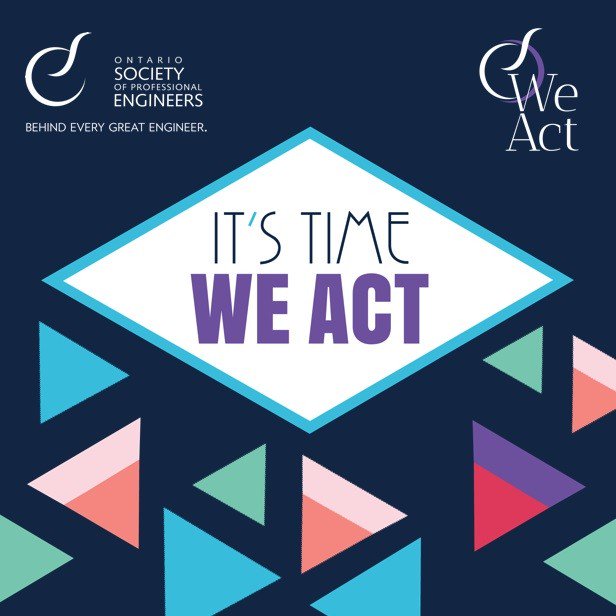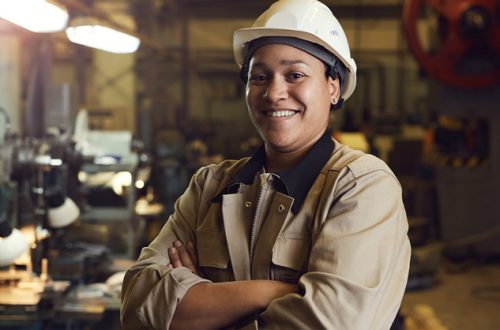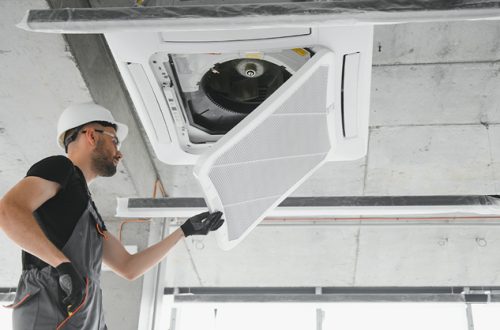The 16th annual Claudette MacKay-Lassonde Fall Forum, presented by OSPE’s Women in Engineering Advocacy Champions Task Force (WE ACT), brought together over 800 enthusiastic engineers, engineering graduates, students, public figures, thought leaders and trailblazers.
Held in our nation’s capital, the conference focused on the importance of engaging, supporting and empowering women in the science, technology, engineering and math (STEM) sectors. The full-day program cultivated lively discussions about the significance of equity and inclusion in achieving innovation, competitiveness and successful enterprises and business units.
Overall, the conference left attendees with new learnings, but also new challenges. The issues are clear, the solutions are achievable, but what is really needed is action. #ItsTimeWEACT.

—
Couldn’t attend OSPE’s Fall Forum? Here are just a few of the highlights:
—
[videopress i5VN9aPK]
Award-winning CBC News Anchor Suhana Meharchand, skillfully injected an optimal balance of reflection, humour and optimism into the Fall Forum, while sharing her own experiences.
“It reminded me of a conversation I had with Gloria Steinem at a dinner party one night. We were talking about the glass ceiling – crashing through the ceiling – and she said that’s not the issue anymore, Suhana. People have crashed through it. It’s about women now understanding that they don’t have to make it difficult for the women who are coming after them. Because according to Gloria, women felt, ‘hey – I had it really hard. It was tough for me; therefore, I have to make it tough for you. That’s an interesting mindset.”
Shelly Deitner, P.Eng., Chair of OSPE’s Women in Engineering Advocacy Champions Task Force (WE ACT), took attendees through a brief history of WE ACT, including a biography of its founder Claudette MacKay-Lassonde.
“Over the past several years, OSPE has worked with Mercer to conduct an annual compensation survey of engineering companies across Canada to measure the wage gap between men and women in engineering. Although the gap has been closing slowly, OSPE’s analysis of 2016 data revealed that the longer one worked in engineering, the wider the wage gap between men and women. In fact, the largest discrepancies were evident in the most senior levels of engineering responsibility, ranging from 7% to 10%. If we consider the pay disparity for women at the most senior level of engineering responsibility, a $15,550 gap amounts to $311,000 for a woman after 20 years.”
“We need to ensure that girls in Canada have equal opportunities. That means both in education and in life. To be free from harassment and objectification. And to make sure that the person they are interviewing with actually believes there should be equal opportunity for young women and professionals. It means that all of us in this room need to mentor women and keep widening the path to success. So it’s not about being ‘the first woman this’ or ‘the trailblazer who did that’ but about real and systemic changes that normalizes women at the top of their field and has a critical mass of women in that field.”
“The roles on gender equality: it is equally as important for men to stand up as it is for women not to sit down… Diversity is about inviting people – inviting women – to the party. Inclusion is about inviting them to dance. I think that when we speak about inclusion, we really have to articulate what we mean and translate that into action. Giving lip service to diversity is only lip service unless you mean that. And that is a management responsibility.”
“As the Deputy Minister of Public Service and Procurement Canada, I’m proud to be part of a public sector that strives for gender equality… For me—whether in government, academia, or in the private sector—those of us in leadership roles need to drive the change. We need to demonstrate equality at the highest levels. Girls and young women need role models. They need to be able to see themselves in science and engineering jobs and they need mentors to provide guidance.”
“Multinationals are great organizations and they all struggle with diversity. The tech sector is notorious for that problem – it takes a lot of effort to move the dial. My own experience working for multinationals is that they do a pretty good job at the top end of companies where very accomplished women can take on senior roles… but it is very, very challenging for any large company to try to attack that issue at the centre of a business – right in the inner kingdom of an organization – where you can help a young female worker throughout her career…”
-
PANEL SESSION 1: WE Innovate: Diversity in the Tech Sector
This panel dove into Canada’s thriving tech sector, including the value of diversity in the tech sector as well as reasons for the current lack of diversity. Our panel of diversity and inclusion experts and tech entrepreneurs shared strategies that government, policymakers, incubators, innovation hubs and industry can use to broaden the talent pool and amplify Canada’s innovation potential.
Moderator: Namir Anani, P.Eng.,President and CEO, Information and Communications Technology Council (ICTC)
“Now the conversation is about creativity and innovation and diversity as a means… Diversity should be measured by two things. The first and foremost is representation. So organizations should be measuring the representation of who their people are. We need to think about all aspects of diversity… the representation numbers are really important because they tell you when you are missing something. Next is the Inclusiveness – how included and valued do people feel?”
“Take a worldview when you are looking at a problem. Understand the people that you are working with and who you are solving the problems for, and more importantly, take advantage of all the people around you to solve that problem. Because things that seem impossible if you just look at it from one group of people working in one place, are perfectly doable somewhere else in the world… if you get global teams together, you will have better ideas, you will have more robust ideas – ideas that will sell.”
“For me, diversity means not just a soft type of social license issue. It’s a fundamental advantage to be diverse because I believe it will lead to more innovation – you are bringing together more cultures, backgrounds and experiences from all sorts of people with unique perspectives that will directly lead to innovation. And I believe that will translate into commercial value...If the technology is diverse and inclusive, why can’t the people making this technology be diverse?”
“Parents have to ask the right questions and encourage the right thing… Parents have a big role to play in breaking down stereotypes. There are so many more resources and programs to make programming easy to teach, easy to learn and fun. Tech is also talking to people. It’s realizing you are not designing something for yourself; you are designing something for somebody else that is probably not exactly like you. Interacting, testing your products – there are a lot of different components to integrate, and people can find their passion in STEM.”
-
PANEL SESSION 2: WE Move: Women in Transportation and Infrastructure
Panelists discussed some of the interesting roles and projects that they have been a part of in the transportation/infrastructure sector. They discussed some of the challenges they’ve encountered in a male-dominated sector and shared advice for those considering a growing variety of career opportunities in this sector.
Moderator: Kim Simmonds, P.Eng., Director, Application Management, CN Rail
“To talk about the hard skills…it’s important to have them and you can’t be afraid to go out and seek them and to seek every opportunity to get them. So that involves being willing to start out in any company or any field that you’re in and getting hands on. And not being afraid to go and try even if you’re not sure. Asking the questions that you don’t know the answer to.”
“When I’m looking as a manger – I look for multidisciplinary teams. The technical aspect is important because I’m not technical. So I need someone to be able to educate me but I also need someone who can translate those technical specs into real language because part of my job as an executive is to sell the vision of the engineers.”
“These male champions truly walk the talk. They’ve changed their language. They’ve role modelled the right behaviours, and more importantly…it’s about a paradigm shift and a rewiring of our thinking. We need to shift from strictly a ‘mentoring’ role to’ sponsoring’ role…when a male leader mentions a female colleague and her accomplishments or contributions, he’s actually sponsoring her…”
“I just believed in what I had to do and I stuck with that… it’s change management. I started something new in the company…and even the internal people – the engineers – I had to convince them. And that wasn’t an easy journey, but it was a nice experience for me…sometimes it’s not because people don’t like you or your idea, but it’s because they don’t understand, and we have this responsibility – I believe – to educate them.”
“In the Canadian Armed Forces right now there are about 17% women. There are over 100 occupations…and everything’s open to women to enroll in or to put down as our options…by 2026, the Canadian Armed Forces want to have 25.1% women in the military. So there is a lot of effort being made to achieve gender equality in our military.”
PANEL SESSION 3: WE Lead: Breaking Barriers for Women in Politics and Leadership
Panelists discussed how their engineering backgrounds enabled them to succeed in politics and/or in a leadership role. They shared some of the barriers they’ve encountered, strategies they’ve used to overcome these obstacles, and reasons we need more women, and women in engineering, in key decision-making roles.
Moderator: Nicole Foster, National Chair, Equal Voice
“Especially as female engineers, our soft skills are key – we are consultative and collaborative. We figure out how to get the problem done. I would continually be tapped for these projects because I get stuff done. So my advice is, look at alternative roles if you are not satisfied in the super technical aspects…”
“My previous supervisor asked me if I would become her new Dirctor General of Audit and Evaluation. So my first reaction was, ‘I’m a chemical engineer. I know nothing about audits or evaluation and I know nothing about your department. Thank you for the opportunity. I think I’m under-qualified for this job.’ ... but I decided I would take the leap of faith and work for her. It helped me build my confidence in a position where I was going in with very little credibility given the fact that I had no background in the area. But by building strong relationships, by learning how to ask for help, by being more comfortable taking risks, it was absolutely the best experience of my career.”
“Often in these conversations, it’s only us women speaking to each other and that’s why I feel that a lot of progress doesn’t get made. But once you have men involved, maybe those conversations will start to change. I’m also happy to several men here. Not only at the conference, but on the panels as well. To me, that’s been exciting in the last little while.”
“One of the first contributions we as women can make is as a role model. To get that diversity in there and make companies look like they are a land of opportunity and to attract those women who change the demographic, who provide diverse talents – and the other 50% of the talent pool – and actually make a big bottom line difference to the profitability of a company and the success of a company.”
“You cannot be scared. We have to develop these skills – the importance of being convincing, of not being scared to say what we think… Volunteering really helps. Being present in places where you can make a difference. I think the triumph is when you are passionate, and you can see your contribution really effectively in the world.”
-
PANEL SESSION 4: WE Grow: Strategies to Stand Out and Succeed
Panelists shared practical tips for standing out in the classroom, workplace or boardroom. They discussed tips for developing professional networks, finding a mentor, building an online brand/presence, negotiating salaries and pursuing opportunities for career advancement.
Moderator: Dr. Kim Jones, PhD, Associate Professor, Chemical Engineering, McMaster University; Chair, Ontario Network of Women in Engineering (ONWiE); Limited Licence from PEO
“Being intentional about who to meet and what to ask them is very important as is authentically engaging people… People that exhibit traits and career paths that look like something you may aspire to – those are the people you want to reach out to. I always say when it comes to networking, being genuine and authentic can go a long way. And not forsaking any interaction and not making assumptions about the people you meet and what they could possibly do for you.”
“Regardless of who I was speaking to, I would never be intimidated by their position or their background, or be influenced by any sort of bias that I might have had about them leading into these conversations or interactions. It was something that my parents taught me when I was younger… I was always taught to have open and engaging conversations with everyone… Have casual outside of work relationships – show that you are a team player and that you are reliable. For me, this meant joining my workplace’s hockey league and showing up every game to be the goalie.”
“For me, early in my career, networking seemed almost like a hinderance and was competing with my career. I had, and still have a very strong work ethic, and networking was not contributing to my projects. So I quickly realized that was a mistake that I was making. So my advice is network. And be yourself when you network…Make networking fun. Be open to engaging with people. It shouldn’t feel like a chore.”
“As for networking, I think for me the biggest piece that I found to really help was to find a way to connect with people outside of engineering, as well as in engineering as well. So really taking the time at meetings when I’d be sitting in the board room and there would be someone from another department – I wouldn’t sit beside my colleagues, I would go sit beside someone from another department to get that chance to learn about what they do and who they are. I found it’s really helped me broaden my knowledge of how the whole industry works.”
“Moving away from your comfort zone, you will meet people with whom you share values. It is a small world. Focus on participating in new activities and getting to know people… I feel like sometimes as women we always want to be 100% perfect, so instead of taking chances and saying, you know what, I’m going to go for 90% in my job and also go for this networking opportunity in another foundation or association or community and develop other skills and give more back to society – this is how I decided to expand and get involved.”
“Establishing and maintaining your credibility is imperative. I assess credibility to include competence, confidence and courage. Resilience at all levels – emotional, physical and physiological is a necessity – you need to be able to bounce back from a ‘taking a hit’ – that comes from the courage of doing.
Leadership at every level and in every role will change. My role has evolved and now sees me bridging the engineering space with the executive leadership decision space. Our collective mission as strong, powerful and brilliant women is to get out of the trenches and into the C-Suite, because from that perch, you can act – you can target your influences, champion with conviction and lead the charge.”
Eden Hennessey, M.A., Psychology, PhD., Research Associate, Laurier Centre for Women in Science, is a data-driven artist who researches diversity promotion and discrimination reduction. Hennessey assess whether women who confront sexism in science face greater social costs than others. She combines art with social psychological research methods to transform her findings into provocative photo-exhibits featuring female scientists. Hennessey showcased interactive photo research exhibits including, #DistractinglyHonest & #FemInSTEM.
-
#ItsTimeWEACT ON SOCIAL MEDIA
OSPE would like to thank everyone who joined in on our online discussions using the #ItsTimeWEACT hashtag – whether from the forum or from afar. Before, during and following the conference, Facebook, Instagram, LinkedIn and Twitter were filled with inspirational messages, new connections, organic conversations, strategic takeaways and motivational goals that elevated the day’s important conversations on equity, diversity and inclusion in STEM.








Leave a Comment